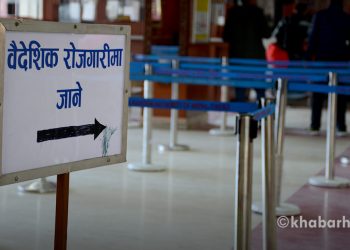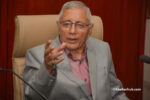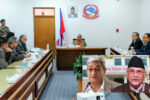KATHMANDU: A noticeable fall in rice production this year is likely to beat the national economy.
Experts predict that it would have its implications on the Gross Domestic Product.
Last year, the contribution of the agricultural sector to the GDP was measured at 27.59 percent.
The Economic Survey of 2075-76 BS had projected the contribution of the agricultural sector (agro products, forest and fishery) to the GDP to be around 26.98 percent. Rice is the staple crop of Nepal and its stake in the GDP is 12 percent.
The Ministry of Agriculture and Livestock Development in a press statement informed that this year paddy production went down by 1.05 percent compared to last year.
It cited lack of timely rainfall, plotting of arable land, inundation in the Tarai/Madhes, lack of sufficient irrigation facilities and youth population deserting from agricultural activities as causes for the drop in rice production.
This year, the country’s rice production fell by 59,000 metric tons compared to the previous fiscal and it was limited to 5,551,000 metric tons against 5610,000 in the last year.
According to the (latest national census which is conducted every 10 years, around 6,000,000 metric tons of rice is required to meet the national demand.
The Agricultural Census 2068 BS states that the agricultural sector has its 32 percent contribution to the GDP.
Despite being an ‘agricultural country’, Nepal is heavily dependent on imports for rice as other agricultural products and so many other commodities. Last year, it imported rice worth Rs 28 billion.
Cultivation of main season rice (which takes place during the rainy season), spring rice (takes place during the Nepali month of Chait or pre-monsoon period) and Ghaiya (a kind of upland rice) is conducted in Nepal.
When we analyze data of the last 15 years (from the fiscal year 2060-61 BS to 2074-75 BS), whether it seems like the major determinant for rice production.
If it is favorable, the production goes up and when it is adverse, the production goes down.
The total arable land in Nepal is 3,091,000 hectares. Rice cropping largely relies on rainfall for water. Of total arable land in Nepal, rice cultivation takes place in around 50 percent.
In the last 15 years, it was the 2060/61 fiscal year that witnessed maximum rice plantation. The rice was planted in 1.5 million hectares of land that year, while the production was 4.4 million tons of rice.
After 11 years in 2072/73, the country planted rice in 1.3 million hectares of land, producing 4.2 million tons of rice.
Every year, the land to produce rice is reducing. The statistics maintained at the Ministry of Agriculture and Livestock Development, however, show that the land for rice cultivation was shrinking but the production growing. Currently, 1.3 million hectares of land is left uncultivated.
According to senior rice specialist Bholaman Singh Basnet, Nepal needs some 6 million metric tons of rice every year.
Interestingly, Nepal houses the highest altitude arable land for rice cultivation- Chhumchaur of Jumla district.
Similarly, Jhapa is the district producing maximum rice.
The government has also announced Jhapa as the super zone of rice production. In Nepal, all districts except Manang and Mustang grow rice.









Comment